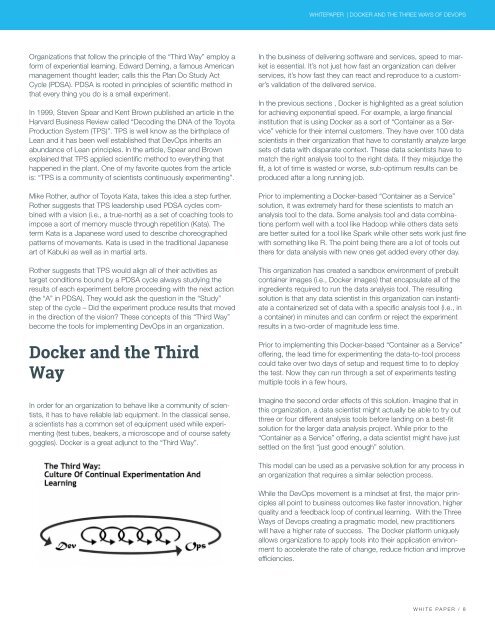Docker and the Three Ways of DevOps
Xks9iQ
Xks9iQ
You also want an ePaper? Increase the reach of your titles
YUMPU automatically turns print PDFs into web optimized ePapers that Google loves.
WHITEPAPER | DOCKER AND THE THREE WAYS OF DEVOPS<br />
Organizations that follow <strong>the</strong> principle <strong>of</strong> <strong>the</strong> “Third Way” employ a<br />
form <strong>of</strong> experiential learning. Edward Deming, a famous American<br />
management thought leader; calls this <strong>the</strong> Plan Do Study Act<br />
Cycle (PDSA). PDSA is rooted in principles <strong>of</strong> scientific method in<br />
that every thing you do is a small experiment.<br />
In 1999, Steven Spear <strong>and</strong> Kent Brown published an article in <strong>the</strong><br />
Harvard Business Review called “Decoding <strong>the</strong> DNA <strong>of</strong> <strong>the</strong> Toyota<br />
Production System (TPS)”. TPS is well know as <strong>the</strong> birthplace <strong>of</strong><br />
Lean <strong>and</strong> it has been well established that <strong>DevOps</strong> inherits an<br />
abundance <strong>of</strong> Lean principles. In <strong>the</strong> article, Spear <strong>and</strong> Brown<br />
explained that TPS applied scientific method to everything that<br />
happened in <strong>the</strong> plant. One <strong>of</strong> my favorite quotes from <strong>the</strong> article<br />
is: “TPS is a community <strong>of</strong> scientists continuously experimenting”.<br />
Mike Ro<strong>the</strong>r, author <strong>of</strong> Toyota Kata, takes this idea a step fur<strong>the</strong>r.<br />
Ro<strong>the</strong>r suggests that TPS leadership used PDSA cycles combined<br />
with a vision (i.e., a true-north) as a set <strong>of</strong> coaching tools to<br />
impose a sort <strong>of</strong> memory muscle through repetition (Kata). The<br />
term Kata is a Japanese word used to describe choreographed<br />
patterns <strong>of</strong> movements. Kata is used in <strong>the</strong> traditional Japanese<br />
art <strong>of</strong> Kabuki as well as in martial arts.<br />
Ro<strong>the</strong>r suggests that TPS would align all <strong>of</strong> <strong>the</strong>ir activities as<br />
target conditions bound by a PDSA cycle always studying <strong>the</strong><br />
results <strong>of</strong> each experiment before proceeding with <strong>the</strong> next action<br />
(<strong>the</strong> “A” in PDSA). They would ask <strong>the</strong> question in <strong>the</strong> “Study”<br />
step <strong>of</strong> <strong>the</strong> cycle – Did <strong>the</strong> experiment produce results that moved<br />
in <strong>the</strong> direction <strong>of</strong> <strong>the</strong> vision? These concepts <strong>of</strong> this “Third Way”<br />
become <strong>the</strong> tools for implementing <strong>DevOps</strong> in an organization.<br />
<strong>Docker</strong> <strong>and</strong> <strong>the</strong> Third<br />
Way<br />
In order for an organization to behave like a community <strong>of</strong> scientists,<br />
it has to have reliable lab equipment. In <strong>the</strong> classical sense,<br />
a scientists has a common set <strong>of</strong> equipment used while experimenting<br />
(test tubes, beakers, a microscope <strong>and</strong> <strong>of</strong> course safety<br />
goggles). <strong>Docker</strong> is a great adjunct to <strong>the</strong> “Third Way”.<br />
In <strong>the</strong> business <strong>of</strong> delivering s<strong>of</strong>tware <strong>and</strong> services, speed to market<br />
is essential. It’s not just how fast an organization can deliver<br />
services, it’s how fast <strong>the</strong>y can react <strong>and</strong> reproduce to a customer’s<br />
validation <strong>of</strong> <strong>the</strong> delivered service.<br />
In <strong>the</strong> previous sections , <strong>Docker</strong> is highlighted as a great solution<br />
for achieving exponential speed. For example, a large financial<br />
institution that is using <strong>Docker</strong> as a sort <strong>of</strong> “Container as a Service”<br />
vehicle for <strong>the</strong>ir internal customers. They have over 100 data<br />
scientists in <strong>the</strong>ir organization that have to constantly analyze large<br />
sets <strong>of</strong> data with disparate context. These data scientists have to<br />
match <strong>the</strong> right analysis tool to <strong>the</strong> right data. If <strong>the</strong>y misjudge <strong>the</strong><br />
fit, a lot <strong>of</strong> time is wasted or worse, sub-optimum results can be<br />
produced after a long running job.<br />
Prior to implementing a <strong>Docker</strong>-based “Container as a Service”<br />
solution, it was extremely hard for <strong>the</strong>se scientists to match an<br />
analysis tool to <strong>the</strong> data. Some analysis tool <strong>and</strong> data combinations<br />
perform well with a tool like Hadoop while o<strong>the</strong>rs data sets<br />
are better suited for a tool like Spark while o<strong>the</strong>r sets work just fine<br />
with something like R. The point being <strong>the</strong>re are a lot <strong>of</strong> tools out<br />
<strong>the</strong>re for data analysis with new ones get added every o<strong>the</strong>r day.<br />
This organization has created a s<strong>and</strong>box environment <strong>of</strong> prebuilt<br />
container images (i.e., <strong>Docker</strong> images) that encapsulate all <strong>of</strong> <strong>the</strong><br />
ingredients required to run <strong>the</strong> data analysis tool. The resulting<br />
solution is that any data scientist in this organization can instantiate<br />
a containerized set <strong>of</strong> data with a specific analysis tool (i.e., in<br />
a container) in minutes <strong>and</strong> can confirm or reject <strong>the</strong> experiment<br />
results in a two-order <strong>of</strong> magnitude less time.<br />
Prior to implementing this <strong>Docker</strong>-based “Container as a Service”<br />
<strong>of</strong>fering, <strong>the</strong> lead time for experimenting <strong>the</strong> data-to-tool process<br />
could take over two days <strong>of</strong> setup <strong>and</strong> request time to to deploy<br />
<strong>the</strong> test. Now <strong>the</strong>y can run through a set <strong>of</strong> experiments testing<br />
multiple tools in a few hours.<br />
Imagine <strong>the</strong> second order effects <strong>of</strong> this solution. Imagine that in<br />
this organization, a data scientist might actually be able to try out<br />
three or four different analysis tools before l<strong>and</strong>ing on a best-fit<br />
solution for <strong>the</strong> larger data analysis project. While prior to <strong>the</strong><br />
“Container as a Service” <strong>of</strong>fering, a data scientist might have just<br />
settled on <strong>the</strong> first “just good enough” solution.<br />
This model can be used as a pervasive solution for any process in<br />
an organization that requires a similar selection process.<br />
While <strong>the</strong> <strong>DevOps</strong> movement is a mindset at first, <strong>the</strong> major principles<br />
all point to business outcomes like faster innovation, higher<br />
quality <strong>and</strong> a feedback loop <strong>of</strong> continual learning. With <strong>the</strong> <strong>Three</strong><br />
<strong>Ways</strong> <strong>of</strong> Devops creating a pragmatic model, new practitioners<br />
will have a higher rate <strong>of</strong> success. The <strong>Docker</strong> platform uniquely<br />
allows organizations to apply tools into <strong>the</strong>ir application environment<br />
to accelerate <strong>the</strong> rate <strong>of</strong> change, reduce friction <strong>and</strong> improve<br />
efficiencies.<br />
WHITE PAPER / 8




